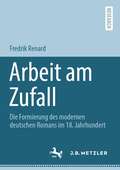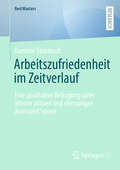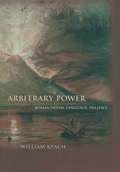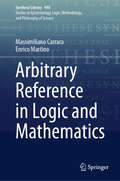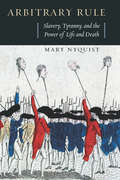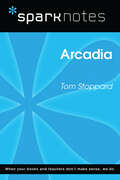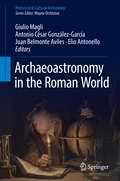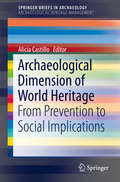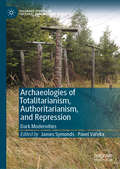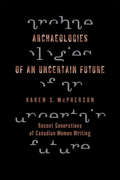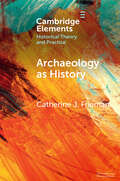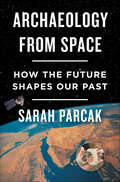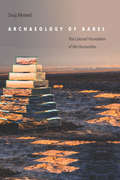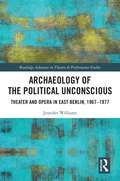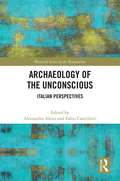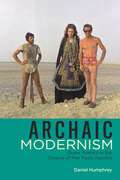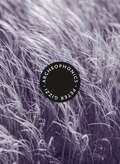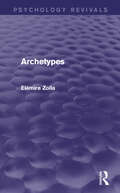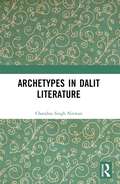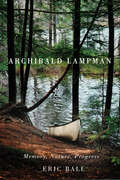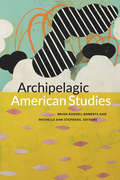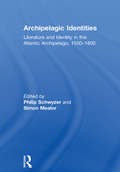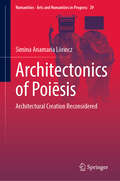- Table View
- List View
Arbeit am Zufall: Die Formierung des modernen deutschen Romans im 18. Jahrhundert
by Fredrik RenardDer Band untersucht das Modernwerden des deutschen Romans im 18. Jahrhundert als eine narrativierte Auseinandersetzung zwischen Zufall und Romanform. Die ‚Arbeit am Zufall‘ beschreibt, wie der moderne Roman sich selbst formt, indem er auf verschiedene Weise Zufälligkeit theoretisiert und narrativiert. Zufall ist in dieser Hinsicht sowohl das, was im Roman an Form gewinnen muss, aber auch das unerschöpfliche Potential, was wiederum den modernen Roman ständig erneuerbar macht.
Arbeitszufriedenheit im Zeitverlauf: Eine qualitative Befragung unter älteren aktiven und ehemaligen Journalist*innen (BestMasters)
by Karoline SteinbockIn einer sich wandelnden Medienwelt sind Fragen nach der Zufriedenheit mit der Arbeit und nach Veränderungen der Zufriedenheit im Laufe des Berufslebens von zentraler Bedeutung. Die Forschungsarbeit geht der Frage nach, wie sich die beruflichen Erwartungen, die Veränderungen in der Medienlandschaft und die individuellen Karriereentscheidungen auf die Zufriedenheit ausgewirkt haben. Durch problemzentrierte Interviews mit ehemaligen, aktiven und bereits pensionierten Journalist*innen bietet die Arbeit wertvolle Einblicke, wie sich die Arbeitszufriedenheit unter dem Einfluss von Faktoren wie der digitalen Transformation und der Medienkrise entwickelt. Darüber hinaus wird untersucht, welche weiteren Faktoren die Arbeitszufriedenheit beeinflusst haben. Diese Untersuchung liefert nicht nur praxisrelevante Erkenntnisse für das Personalmanagement und die Organisationsentwicklung in der Medienbranche, sondern bietet auch eine tiefgehende Reflexion über die Arbeitswelt von Journalist*innen in einem sich ständig wandelnden Umfeld.
Arbitrary Power: Romanticism, Language, Politics
by William KeachThis book explores previously unexamined links between the arbitrary as articulated in linguistic theories on the one hand, and in political discourse about power on the other. In particular, Willam Keach shows how Enlightenment conceptions of the arbitrary were contested and extended in British Romantic writing. In doing so, he offers a new paradigm for understanding the recurrent problem of verbal representation in Romantic writing and the disputes over stylistic performance during this period. With clarity and force, Keach reads these phenomena in relation to a rapidly shifting literary marketplace and to the social pressures in Britain generated by the French Revolution, the Napoleonic Wars, and the class antagonisms that culminated in the Peterloo Massacre. The question of what it means to think of language or politics as arbitrary persists through postmodern thinking, and this book advances an unfinished dialogue between Romantic culture and the critical techniques we currently use to analyze it. Keach's intertwined linguistic and political account of arbitrary power culminates in a detailed textual analysis of the language of revolutionary violence. Including substantial sections on Blake, Wollstonecraft, Wordsworth, Coleridge, Byron, P. B. Shelley, Keats, and Anna Jameson, Arbitrary Power will engage not only students and scholars of eighteenth- and nineteenth-century literature but also those interested in critical and linguistic theory and in social and political history.
Arbitrary Reference in Logic and Mathematics (Synthese Library #490)
by Enrico Martino Massimiliano CarraraThis book develops a new approach to plural arbitrary reference and examines mereology, including considering four theses on the alleged innocence of mereology. The authors have advanced the notion of plural arbitrary reference in terms of idealized plural acts of choice, performed by a suitable team of agents. In the first part of the book, readers will discover a revision of Boolosʼ interpretation of second order logic in terms of plural quantification and a sketched structuralist reconstruction of second-order arithmetic based on the axiom of infinite, a la Dedekind, as the unique non-logical axiom. The work goes on to analyse the pros and cons of the new interpretation, also with respect to Linneboʼs objections to the thesis that second order logic is genuine logic. A theory of concepts that can be labelled as a theory of logical concepts is expounded. In the second part of the book, the authors consider grounding megethology on plural arbitrary reference and argue that the arguments for the ontological innocence of mereology are not conclusive and that – for a certain use of mereology – a thesis of innocence, similar to that of plural arbitrary reference, is defensible. The work proposes a virtual theory of mereology in which the role of individuals is played by plural choices of atoms. This considered work will appeal to scholars from branches of analytic philosophy, logic and the philosophy of mathematics in particular.
Arbitrary Rule: Slavery, Tyranny, and the Power of Life and Death
by Mary NyquistSlavery appears as a figurative construct during the English revolution of the mid-seventeenth century, and again in the American and French revolutions, when radicals represent their treatment as a form of political slavery. What, if anything, does figurative, political slavery have to do with transatlantic slavery? In Arbitrary Rule, Mary Nyquist explores connections between political and chattel slavery by excavating the tradition of Western political thought that justifies actively opposing tyranny. She argues that as powerful rhetorical and conceptual constructs, Greco-Roman political liberty and slavery reemerge at the time of early modern Eurocolonial expansion; they help to create racialized "free" national identities and their "unfree" counterparts in non-European nations represented as inhabiting an earlier, privative age. Arbitrary Rule is the first book to tackle political slavery's discursive complexity, engaging Eurocolonialism, political philosophy, and literary studies, areas of study too often kept apart. Nyquist proceeds through analyses not only of texts that are canonical in political thought--by Aristotle, Cicero, Hobbes, and Locke--but also of literary works by Euripides, Buchanan, Vondel, Montaigne, and Milton, together with a variety of colonialist and political writings, with special emphasis on tracts written during the English revolution. She illustrates how "antityranny discourse," which originated in democratic Athens, was adopted by republican Rome, and revived in early modern Western Europe, provided members of a "free" community with a means of protesting a threatened reduction of privileges or of consolidating a collective, political identity. Its semantic complexity, however, also enabled it to legitimize racialized enslavement and imperial expansion. Throughout, Nyquist demonstrates how principles relating to political slavery and tyranny are bound up with a Roman jurisprudential doctrine that sanctions the power of life and death held by the slaveholder over slaves and, by extension, the state, its representatives, or its laws over its citizenry.
Arcadia (SparkNotes Literature Guide Series)
by SparkNotesArcadia (SparkNotes Literature Guide) by Tom Stoppard Making the reading experience fun! Created by Harvard students for students everywhere, SparkNotes is a new breed of study guide: smarter, better, faster.Geared to what today's students need to know, SparkNotes provides:*chapter-by-chapter analysis *explanations of key themes, motifs, and symbols *a review quiz and essay topics Lively and accessible, these guides are perfect for late-night studying and writing papers.
Archaeoastronomy in the Roman World (Historical & Cultural Astronomy)
by Giulio Magli Antonio César González-García Juan Belmonte Aviles Elio AntonelloThis book explores the insights that Cultural Astronomy provides into the classical Roman world by unveiling the ways in which the Romans made use of their knowledge concerning the heavens, and by shedding new light on the interactions between astronomy and heritage in ancient Roman culture. Leading experts in the field present fascinating information on how and why the Romans referred to the sky when deciding upon the orientation of particular monuments, temples, tombs and even urban layouts. Attention is also devoted to questions of broader interest, such as the contribution that religious interpretation of the sky made in the assimilation of conquered peoples.When one considers astronomy in the Roman world it is customary to think of the work and models of Ptolemy, and perhaps the Julian calendar or even the sighting of the Star of Bethlehem. However, like many other peoples in antiquity, the Romans interacted with the heavens in deeper ways that exerted a profound influence on their culture. This book highlights the need to take this complexity into account in various areas of research and will appeal to all those who wish to learn more about the application of astronomy in the lives and architecture of the Romans.
Archaeological Dimension of World Heritage: From Prevention to Social Implications (SpringerBriefs in Archaeology)
by Alicia CastilloThis volume presents case studies from around the world aiming to serve as a hands-on book for management and treatment of archaeological World Heritage properties. It comprises not only sites inscribed as World Heritage due to their archaeological character but also World Heritage properties where the analysis of their archaeological dimension provides a deeper and better understanding of the assets and includes the potential for disseminating this knowledge. The book has an important practical value, since all the works presented here illustrate - with practical examples, the best and most appropriate ways to manage World Heritage properties. The aim of the heritage managers at these World Heritage sites is to improve conservation and increase understanding and communication in such a way that the communities living in those sites or who earn a livelihood from them can be positively affected by these initiatives. The book presents exemplary models of heritage management in World Heritage properties-an issue not treated in depth up to now and Best Practices in this management. Therefore, this volume becomes a new, original source presenting model strategies to be followed by other initiatives in order to improve the consideration and treatment of the most outstanding valued sites considered by UNESCO.
Archaeologies of Totalitarianism, Authoritarianism, and Repression: Dark Modernities (Palgrave Studies in Cultural Heritage and Conflict)
by James Symonds Pavel VařekaThis book offers new insights into the mechanisms of state control, systematic repression and mass violence focused on ethnic, political, class, and religious minorities in the recent past. The geographical and temporal scope of the volume breaks new ground as international scholars foreground how contemporary archaeology can be used to enhance the documentation and interpretation of totalitarian and authoritarian regimes, to advance theoretical approaches to atrocities, and to broaden public understandings of how such regimes use violence and repression to hold on to power.
Archaeologies of an Uncertain Future: Recent Generations of Canadian Women Writing
by Karen McPhersonIn Archaeologies of an Uncertain Future, McPherson explores the memory work, alternative historiographies, and feminist aesthetics by which women writers revisit the past and reimagine the future. Grounded within critical discourses across many discplines, McPherson's analysis engages contemporary discussions about autobiographical genres, post-modern historiographies, memoirs, and literary genealogies.
Archaeology as History: Telling Stories from a Fragmented Past (Elements in Historical Theory and Practice)
by Catherine J. FriemanThis Element volume focuses on how archaeologists construct narratives of past people and environments from the complex and fragmented archaeological record. In keeping with its position in a series of historiography, it considers how we make meaning from things and places, with an emphasis on changing practices over time and the questions archaeologists have and can ask of the archaeological record. It aims to provide readers with a reflexive and comprehensive overview of what it is that archaeologists do with the archaeological record, how that translates into specific stories or narratives about the past, and the limitations or advantages of these when trying to understand past worlds. The goal is to shift the reader's perspective of archaeology away from seeing it as a primarily data gathering field, to a clearer understanding of how archaeologists make and use the data they uncover.
Archaeology from Space: How the Future Shapes Our Past
by Sarah ParcakWinner of Archaeological Institute of America's Felicia A. Holton Book Award • Winner of the Phi Beta Kappa Prize for Science • An Amazon Best Science Book of 2019 • A Science Friday Best Science Book of 2019 • A Kirkus Reviews Best Nonfiction Book of 2019 • A Science News Best Book of 2019 • Nature's Top Ten Books of 2019 "A crash course in the amazing new science of space archaeology that only Sarah Parcak can give. This book will awaken the explorer in all of us." ?Chris Anderson, Head of TEDNational Geographic Explorer and TED Prize-winner Dr. Sarah Parcak gives readers a personal tour of the evolution, major discoveries, and future potential of the young field of satellite archaeology. From surprise advancements after the declassification of spy photography, to a new map of the mythical Egyptian city of Tanis, she shares her field’s biggest discoveries, revealing why space archaeology is not only exciting, but urgently essential to the preservation of the world’s ancient treasures.Parcak has worked in twelve countries and four continents, using multispectral and high-resolution satellite imagery to identify thousands of previously unknown settlements, roads, fortresses, palaces, tombs, and even potential pyramids. From there, her stories take us back in time and across borders, into the day-to-day lives of ancient humans whose traits and genes we share. And she shows us that if we heed the lessons of the past, we can shape a vibrant future. Includes Illustrations
Archaeology of Babel: The Colonial Foundation of the Humanities
by Siraj AhmedFor more than three decades, preeminent scholars in comparative literature and postcolonial studies have called for a return to philology as the indispensable basis of critical method in the humanities. Against such calls, this book argues that the privilege philology has always enjoyed within the modern humanities silently reinforces a colonial hierarchy. In fact, each of philology's foundational innovations originally served British rule in India. Tracing an unacknowledged history that extends from British Orientalist Sir William Jones to Palestinian American intellectual Edward Said and beyond, Archaeology of Babel excavates the epistemic transformation that was engendered on a global scale by the colonial reconstruction of native languages, literatures, and law. In the process, it reveals the extent to which even postcolonial studies and European philosophy—not to mention discourses as disparate as Islamic fundamentalism, Hindu nationalism, and global environmentalism—are the progeny of colonial rule. Going further, it unearths the alternate concepts of language and literature that were lost along the way and issues its own call for humanists to reckon with the politics of the philological practices to which they now return.
Archaeology of the Political Unconscious: Theater and Opera in East Berlin, 1967–1977 (ISSN)
by Jennifer WilliamsThis book investigates the aesthetic and political dialectics of East Berlin to argue how its theater and opera stages incited artists to act out, fuel, and resist the troubled construction of political legitimacy.This volume investigates three case studies of how leading East Berlin stages excavated fragmentary materials from Weimar dramatist Bertolt Brecht’s oeuvre and repurposed them for their post‑fascist society: Uta Birnbaum’s 1967 Man Equals Man at the Berliner Ensemble, Joachim Herz’s 1977 Rise and Fall of the City of Mahagonny at the Komische Oper, and Heiner Muller’s own productions of his trailblazing plays. In each instance, reused theatrical artifacts dialectically expressed the contradictions inherent in East German political legitimacy, at once amplifying and critiquing it. Illuminated by original archival research and translations of letters and artistic ephemera published in English for the first time, and engaging with alternative East German feminist epistemologies, this book’s critical investigation of culture and political legitimacy in the shadow of Germany’s fascist past resonates beyond the Iron Curtain into the twenty‑first century. Its final chapter examines how performative artifacts influence the process of political legitimation in more recent history, ranging from Checkpoint Charlie tourism to the January 6, 2021 US insurrection.This study will be of great interest to students and scholars in theater and performance studies, art history, musicology, German studies, anthropology, and political science.
Archaeology of the Unconscious: Italian Perspectives (Warwick Series in the Humanities)
by Alessandra Aloisi Fabio CamillettiIn reconstructing the birth and development of the notion of ‘unconscious’, historians of ideas have heavily relied on the Freudian concept of Unbewussten, retroactively projecting the psychoanalytic unconscious over a constellation of diverse cultural experiences taking place in the eighteenth and nineteenth centuries between France and Germany. Archaeology of the Unconscious aims to challenge this perspective by adopting an unusual and thought-provoking viewpoint as the one offered by the Italian case from the 1770s to the immediate aftermath of WWI, when Italo Svevo’s La coscienza di Zeno provides Italy with the first example of a ‘psychoanalytic novel’. Italy’s vibrant culture of the long nineteenth century, characterised by the sedimentation, circulation, intersection, and synergy of different cultural, philosophical, and literary traditions, proves itself to be a privileged object of inquiry for an archaeological study of the unconscious; a study whose object is not the alleged ‘origin’ of a pre-made theoretical construct, but rather the stratifications by which that specific construct was assembled. In line with Michel Foucault’s Archéologie du savoir (1969), this volume will analyze the formation and the circulation, across different authors and texts, of a network of ideas and discourses on interconnected themes, including dreams, memory, recollection, desire, imagination, fantasy, madness, creativity, inspiration, magnetism, and somnambulism. Alongside questioning pre-given narratives of the ‘history of the unconscious’, this book will employ the Italian ‘difference’ as a powerful perspective from whence to address the undeveloped potentialities of the pre-Freudian unconscious, beyond uniquely psychoanalytical viewpoints.
Archaic Modernism: Queer Poetics in the Cinema of Pier Paolo Pasolini (Queer Screens)
by Daniel HumphreyIn Archaic Modernism, Daniel Humphrey offers the first book-length, English-language examination of three adaptations of Greek tragedy produced by the gay and Marxist Italian filmmaker Pier Paolo Pasolini: Oedipus Rex (1967), Medea (1969), and Notes Towards an African Orestes (1970/1973). Considering Pasolini’s own theories of a "Cinema of Poetry" alongside Jacques Derrida’s concept of écriture, as well as more recent scholarship by queer theory scholars advocating for an antirelational and antisocial subjectivity, Humphrey maintains that Pasolini’s Greek tragedy films exemplify a paradoxical sense of "archaic modernism" that is at the very heart of the filmmaker’s project. More daringly, he contends that they ultimately reveal the queer roots of Western civilization’s formative texts. Archaic Modernism is comprised of three chapters. Chapter 1 focuses on Oedipus Rex, assessing both the filmic language employed and the deeply queer mythological source material that haunts the tragedy even as it remains largely at a subtextual yet palpable level. Chapter 2 extends and deepens the concept of queer fate and queer negativity in a scene-by-scene analysis of Medea. Chapter 3 looks at the most obscure of Pasolini’s feature length films, Notes Towards an African Orestes, a film long misunderstood as an unwitting failure, but which could perhaps best be understood as a deliberate, sacrificial act on the filmmaker’s part. Considering the film as the third in an informal, maybe unconscious, trilogy, Humphrey concludes his monograph by arguing that this "trilogy of myth" can best be understood as a deconstruction, gradually more and more severe, of three of the most important origin tales of Western civilization. Archaic Modernism makes the case that these three films are as essential as those Pasolini films more often studied in the Anglophone world: Mamma Roma, The Gospel According to Matthew, Teorema, The Trilogy of Life, and Salò, and that they are of continuing, perhaps even increasing, value today. This book is of specific interest to scholars, students, and researchers of film and queer studies.
Archaic Style in English Literature, 1590-1674
by Lucy MunroRanging from the works of Shakespeare, Spenser, Jonson and Milton to those of Robert Southwell and Anna Trapnel, this groundbreaking study explores the conscious use of archaic style by the poets and dramatists between 1590 and 1674. It focuses on the wide-ranging, complex and self-conscious uses of archaic linguistic and poetic style, analysing the uses to which writers put literary style in order to re-embody and reshape the past. Munro brings together scholarly conversations on temporality, memory and historiography, on the relationships between medieval and early modern literary cultures, on the workings of dramatic and poetic style, and on national history and identity. Neither pure anachronism nor pure nostalgia, the attempts of writers to reconstruct outmoded styles within their own works reveal a largely untold story about the workings of literary influence and tradition, the interactions between past and present, and the uncertain contours of English nationhood.
Archeophonics (Wesleyan Poetry Ser.)
by Peter GizziSoulful and intricate lyrics make this Gizzi's strongest book to dateArcheophonics is the first collection of new work from the poet Peter Gizzi in five years. Archeophonics, defined as the archeology of lost sound, is one way of understanding the role and the task of poetry: to recover the buried sounds and shapes of languages in the tradition of the art, and the multitude of private connections that lie undisclosed in one's emotional memory. The book takes seriously the opening epigraph by the late great James Schuyler: "poetry, like music, is not just song." It recognizes that the poem is not a decorative art object but a means of organizing the world, in the words of anthropologist Clifford Geertz, "into transient examples of shaped behavior." Archeophonics is a series of discrete poems that are linked by repeated phrases and words, and its themes and nothing less than joy, outrage, loss, transhistorical thought, and day-to-day life. It is a private book of public and civic concerns.
Archetypes (Psychology Revivals)
by Elémire ZollaMan is dominated by his archetypes; they mould not only his history but his dreams. But how are we to define and evaluate them? Is it perhaps possible for us to relate more creatively to them? Originally published in 1981, these are some of the questions raised by this title. To answer them the author gathered together a vast amount of material drawn from Eastern and Western traditions, from science, literature, art and poetry. The answers he puts forward are often highly original and will surely challenge many of our most cherished patterns of thought. There emerges from this book what can only be described as a global metaphysical system, yet the author’s language is not that of an ordinary metaphysical treatise, and what he writes offered new challenge and hope to those suffering from the despair and cynicism engendered by a great deal in modern society at the time. Zolla does not, however, advocate a return to earlier historical patterns, nor is he proposing a new Utopia, but rather offers us a brilliant series of lessons in the art of centring. In the words of Bernard Wall, writing in the Times Literary Supplement, Zolla’s ‘deep, polymathic probing of the terms of human existence makes it sensible to compare him with Simone Weil, while some of his conclusions about ultimate mysteries – expressed in signs, symbols and sacraments, the sense of which we have lost – will make us think of the later T. S. Eliot’.
Archetypes in Dalit Literature
by Chandna Singh NirwanArchetypes in Dalit Literature examines the role of the multitudinous archetypes and myths in understanding the evolution of the psyche and consciousness of the Parayar Dalit community based out of Tamil Nadu, India. This book also examines the other Dalit communities like Bhangis, Chuhras and Madigas through the lens of Archetypal criticism. This is a nuanced take on Dalit Studies where Western thought and theory have been applied to the colossal work of a Tamil Dalit writer, Bama and others (Mulk Raj Anand, Omprakash Valmiki, Sharankumar Limbale and Perumal Murugan) to comprehend the community archetypal characters, setting, myths, rituals, and language. A detailed analysis of the Jungian archetypes of Rebirth, Mother, Spirit and Trickster has helped in acquiring an understanding of the so-called lower caste, their circumstances, their life and experiences. Among the seminal works on myth criticism are Joseph Campbell's ‘Monomyth’ and Vladimir Propp's ‘Functions’. One of Bama’s works, Vanmam (2008) largely adheres to these structures which makes it a good example of fiction based on reality and thereby, also making it at par with the mainstream Indian Writing in English. Chandna has also analyzed the significance of community myths, stories, and folklore using the concept of implicit mythology. This book also studies the Dalit language as a special case and unfolds various meanings about the culture, community, and people in context. An important finding is that the language of marginalization is very much a reality. Bama’s narratives are true representations of the journey of the Parayar Dalit identity formation and the changes it has undergone over time. The study of the different aspects of the lives, ideologies, and culture of the marginalized section of Indian society as represented by these writers in their works has enhanced the understanding of their significant role and contribution to Indian society which may not have, over time been acknowledged, yet undeniably needs to be appreciated and celebrated.
Archibald Lampman
by Eric BallTreasuring the past, savouring the present, and wanting to do right by the future, Archibald Lampman was a poet keenly focused on the workings of time. He was also a thinker of mystical predisposition. His goal was not to transcend time, but to find redemptive meaning within it. Archibald Lampman: Memory, Nature, Progress explores the ways in which Lampman pursued this goal in relation to the three faces of time. Memory fascinated Lampman. He relished the "alchemy" by which the dross of past experience could be left behind and the gold preserved. Nature compelled his mind and emotions, and his clear-eyed observations of both countryside and wilderness settings gave rise to a self-evolved poetics of inclusiveness. In his celebrations of nature in all its manifestations, mild or bleak, he anticipated the work of iconic Canadian painter Tom Thomson and he forecasted the environmentalism of our own time. Progress for Lampman spelled societal rectification. By forwarding the cause of social betterment, one was part of a movement larger than oneself, and this expansion, too, was redemptive. Archibald Lampman: Memory, Nature, Progress is the first book on this foundational figure in Canadian literature to appear in over twenty-five years and the first thematically focused study. Combining close analysis with biographical context, it shows how Lampman's oeuvre was shaped by his responses to his physical surroundings and to his social-intellectual milieu, as filtered through his stubbornly independent outlook.
Archibald Lampman: Memory, Nature, Progress
by Eric BallTreasuring the past, savouring the present, and wanting to do right by the future, Archibald Lampman was a poet keenly focused on the workings of time. He was also a thinker of mystical predisposition. His goal was not to transcend time, but to find redemptive meaning within it. Archibald Lampman: Memory, Nature, Progress explores the ways in which Lampman pursued this goal in relation to the three faces of time. Memory fascinated Lampman. He relished the “alchemy” by which the dross of past experience could be left behind and the gold preserved. Nature compelled his mind and emotions, and his clear-eyed observations of both countryside and wilderness settings gave rise to a self-evolved poetics of inclusiveness. In his celebrations of nature in all its manifestations, mild or bleak, he anticipated the work of iconic Canadian painter Tom Thomson and he forecasted the environmentalism of our own time. Progress for Lampman spelled societal rectification. By forwarding the cause of social betterment, one was part of a movement larger than oneself, and this expansion, too, was redemptive. Archibald Lampman: Memory, Nature, Progress is the first book on this foundational figure in Canadian literature to appear in over twenty-five years and the first thematically focused study. Combining close analysis with biographical context, it shows how Lampman’s oeuvre was shaped by his responses to his physical surroundings and to his social-intellectual milieu, as filtered through his stubbornly independent outlook.
Archipelagic American Studies
by Brian Russell Roberts Michelle Ann StephensDeparting from conventional narratives of the United States and the Americas as fundamentally continental spaces, the contributors to Archipelagic American Studies theorize America as constituted by and accountable to an assemblage of interconnected islands, archipelagoes, shorelines, continents, seas, and oceans. They trace these planet-spanning archipelagic connections in essays on topics ranging from Indigenous sovereignty to the work of Édouard Glissant, from Philippine call centers to US militarization in the Caribbean, and from the great Pacific garbage patch to enduring overlaps between US imperialism and a colonial Mexican archipelago. Shaking loose the straitjacket of continental exceptionalism that hinders and permeates Americanist scholarship, Archipelagic American Studies asserts a more relevant and dynamic approach for thinking about the geographic, cultural, and political claims of the United States within broader notions of America. Contributors Birte Blascheck, J. Michael Dash, Paul Giles, Susan Gillman, Matthew Pratt Guterl, Hsinya Huang, Allan Punzalan Isaac, Joseph Keith, Yolanda Martínez-San Miguel, Brandy Nalani McDougall, Ifeoma Kiddoe Nwankwo, Craig Santos Perez, Brian Russell Roberts, John Carlos Rowe, Cherene Sherrard-Johnson, Ramón E. Soto-Crespo, Michelle Ann Stephens, Elaine Stratford, Etsuko Taketani, Alice Te Punga Somerville, Teresia Teaiwa, Lanny Thompson, Nicole A. Waligora-Davis
Archipelagic Identities: Literature and Identity in the Atlantic Archipelago, 1550–1800
by Simon MealorArchipelagic Identities explores the invention and interplay of national, regional and linguistic identities in the literatures of early modern Britain and Ireland. The volume includes innovative work by leading practitioners of British studies, and sheds new light on classic cases such as Edmund Spenser's Irish experience, whilst also introducing less familiar writers and texts, such as Anne Dowriche's The French Historie, William Browne's Britannia Pastorals, William Richards' Wallography, Anne Bradstreet's 'Dialogue between Old England and New', and the works of Gaelic bards and French Huguenot refugees. Foregrounding issues of gender, class and migratory identity which have not previously received significant attention in this field, Archipelagic Identities brings British studies into the mainstream of contemporary literary criticism.
Architectonics of Poiēsis: Architectural Creation Reconsidered (Numanities - Arts and Humanities in Progress #29)
by Simina Anamaria LörinczThis volume explores the meaning of the architectural creative act, following the dynamics of the relationship between creator-creative act-creation and the way in which architecture is defined over time, as a creative act both material and symbolic. Two protagonists, Antonio Averlino (Filarete) and Christopher Alexander, are singled out under the guiding concepts of poíēsis and poeta faber. The book initiates a dialogue over time between their works and concepts, engaging two cultures, the Renaissance and the contemporary, symbolically chosen for their importance in redefining the profession through the prism of its relation to the architectural creative act. The core idea revolves around rediscovering the humanistic approach to architecture in and for the contemporary context, and using it in order to better understand architectural creation. This text appeals to students and researchers working in the history and theory of architecture, product, industrial design, and semiotics.
